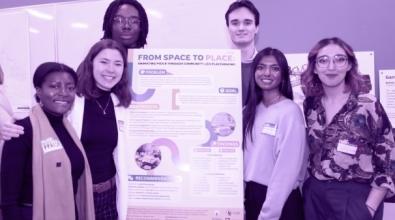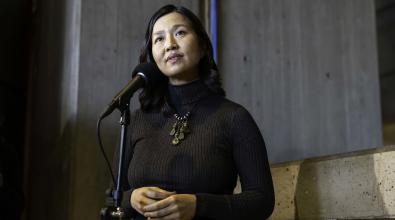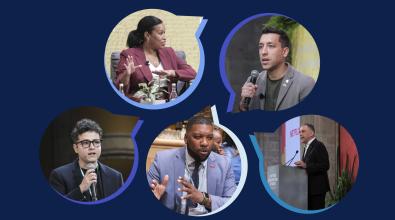 Read More
Read More
Storytelling brought this city together to secure a resilient future
Photos courtesy city of Boise
Listen to This Article
When crises strike communities, it’s often immediately clear to residents and local leaders alike that they need to come together to take action. But sometimes, challenges further out on the horizon call for a decisive response without offering the same clarity.
That’s why Boise, Idaho, has used storytelling techniques to generate a sense of shared purpose and urgency around a complicated technical challenge that can feel removed from residents’ day-to-day lives: water-renewal capacity. Now, a nearly decade-long effort that began with a climate risk assessment is set to break ground next year on a recycling plant that diverts six million gallons of water per day for purification. The project—which helped the city earn the Bloomberg Philanthropies What Works Cities Certification for exceptional data capabilities—could prove especially crucial in light of waves of drought that have struck cities across the Americas in recent years.
To get here, city leaders worked with residents to tease out values around sustainability, using these insights to develop a new narrative for water issues—and successfully build supermajority support for change from the ground up. Critically, the city conveyed dense concepts in a new, more understandable manner, transforming what might have seemed like abstract government action into relatable efforts. Their work shows that storytelling tools aren’t just a way to engage communities in the short term; they can also help build a joint vision for tackling complex challenges that stands the test of time.
“Boiseans are passionate about protecting our clean air and water, and challenge us to pursue initiatives that protect the place we love and prepare us for a climate constrained future," Boise Mayor Lauren McLean tells Bloomberg Cities. "By keeping the values and experiences that matter most to our residents top of mind, we've transformed a challenging issue into a collective mission that supports sustainable water renewal.”
Building a shared narrative, piece by piece.
In 2016, Boise leaders conducted a data-driven climate-risk assessment and found that six of the top eight red flags on the horizon were related to water. In the city of about 250,000 people, roughly 70 percent of water comes from aquifers and 30 percent from the Boise River—both of which face long-term strain from irrigation, shrinking snowpack, and increasing drought frequency. And while a private company supplies residents' tap water, it’s a city utility that currently collects and cleans millions of gallons of used water that goes down drains each day, returning it to the river to flow downstream. New public capacity geared at recycling water for reuse—specifically focused on water used by local business and industry—emerged as a potential key ingredient for putting the city on a sustainable path.
So leaders set out to learn what the public already knew about their water and identify what they cared about—what their values were. This work began with traditional surveys, and grew in scope to include an advisory group carefully curated to be representative of the larger population, providing a treasure trove of qualitative data as a baseline for action. Ultimately, what city leaders learned was that many residents supported the idea of recycling water to plan for the future.
But early on, the city was using an outdated vocabulary disconnected from residents’ understanding of the issues at play. “Frankly, people [didn’t] really even know what service we provide or who we are at that time,” recalls Haley Falconer, a senior manager for the city’s Department of Public Works.
So the city changed some of the language it was using to connect with residents. For instance, leaders left behind the term “wastewater” in favor of a phrase suited to planning for the future—“water renewal”—and a tagline to go with it: “We give new life to used water.” And since building a shared narrative also means being inclusive, when the city found in one focus group that the phrase “aquifer recharge” might not be resonating in Spanish-language communities, it replaced that phrase, too, instead using the term “groundwater recharge” in both Spanish and English.
In the years since, the city has used its social media channels to engage in concerted messaging around these themes, deploying a shared language for collective action.
Using sensory experiences to connect on a human level.
As the city started working more deeply with residents around water sustainability, it launched a continuous loop of seeking community feedback, starting technical work, testing possible solutions, and meeting again with residents to hash out next steps. But to really make systematic progress, the effort needed to reach the larger population. Outreach included traditional steps, such as postcards sent to residents, but also got more creative.
The city teamed up with a consortium of utility companies, brewers, and engineering and tech firms to put on events where residents were invited to taste recycled water that had been purified and used to brew beer. These sorts of events were crucial because they offered an opportunity to build a personal and sensory connection with residents, who experienced the technology behind water recycling directly. This, in turn, bolstered the narrative that recycled water is not dirty—that it was safe for them and their family, and that it could be a part of their city’s future.
“That was really helpful in setting the stage with the community about getting comfortable with this,” says Kyle Patterson, Boise’s chief innovation officer.
Ultimately, efforts like this helped make water recycling a massively popular cause, as best captured by over 80 percent of residents voting to support a $570 million bond to fund the new recycling plant in 2021.
Showing clear signs of progress—and spreading the word.
It can be helpful to storytelling in cities to shine a light on “catalyst” projects or “system demonstrators.” These efforts showing incremental progress can make city efforts feel more tangible—and help generate enthusiasm. And that’s exactly what leaders have done in Boise.
City leaders knew addressing their water challenge required a technical solution, one built around concepts that might seem foreign to most residents. So they opened up trailers housing an ongoing pilot project for the new water recycling effort that displays the technology cleaning the water and invites residents to visit. As part of that work, staff wrapped the trailers in graphics explaining the processes in play. Now, the trailers feature both arcane technology and simple narrative threads such as “Right water, right use,” and “Keep water local.” Taken together, the text and images tap into civic pride, build off of residents’ emotional connection to Boise, and paint a clear picture of how this process will change the city in the future.
The city’s effort to create immersive experiences in service of a larger narrative around climate action doesn’t stop here. Boise’s next step: using the renovation of the city’s water education center to incorporate a larger focus on climate into what may be the first combined water and climate education center operated by a municipality in the United States. Visitors will be able to explore exhibits tying together the threads of water and climate action in Boise. Crucially, the city will frame them as positive approaches for the future rather than just reactions to a negative threat in the present.
As Falconer puts it, these spaces can help build a “Boise-centered climate narrative, but with personal action” embedded at their core. In doing so, they cement water renewal in the public consciousness—now and for the future.

